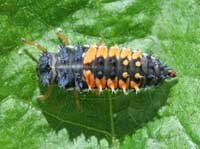
-
Soybean Diseases
- Asian Rust
- Anthracnose
- Bacterial Blight
- Bacterial Pustule
- Bean Pod Mottle Virus
- Brown Stem Rot
- Cercospora Leaf Blight
- Charcoal Rot
- Downy Mildew
- Frogeye Leaf Spot
- Green Stem Syndrome
- Iron Deficiency Chlorosis
- Phytophthora Root & Stem Rot
- Powdery Mildew
- Rhizoctonia
- Seedling Diseases
- Septoria (Brown Spot)
- SCN (Soybean Cyst Nematode)
- Soybean Mosaic Virus
- Stem Canker
- Sudden Death Syndrome
- Viruses
- White Mold
- Soybean Pests
- Diagnostic Help
- Field Trials
- Soybean Library
| Pest: Aphids |
| Soybean aphid biological control |
| Links |
Your Soybean Checkoff.
Delivering Results.
Illinois
Indiana
Iowa
Kansas
Michigan
Minnesota
Missouri
Nebraska
North Dakota
Ohio
South Dakota
Wisconsin
Soybean aphid biological control
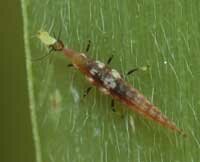
|
| Lacewing larvae eating a soybean aphid. Photo credit: Thelma Heidel-Baker Click on image to view a larger version.. |
Aphids are slow-moving, succulent, and generally poorly protected from predators. Therefore, they have many natural enemies. The soybean aphid is only a sporadic pest in most of it's native range in China, Japan, and Korea because of the presence of parasites and predators that keep them in check.
The soybean aphid would be a far more damaging pest were it not for naturally-occurring biological control. For example, in a recent study of 22 locations in the north central region, more than 50% of aphid-infested fields were kept below threshold level by predators.
Even though the soybean aphid is a recently-identified pest in North America, aphid predators and parasites are already present in soybean fields and have the ability to delay or prevent severe outbreaks.
Strategies to maximize biological control
Entomologists are working on a multi-pronged approach to maximize the impact of biological control in soybean fields, including:
- Importation of specialist natural enemies to augment resident natural enemy populations. This is called "classical biological control", in which the native range of an introduced pest is explored to identify natural enemies for importation into the United States. A major advantage of this form of biological control is that once it is established, it is free of charge to growers. Read more about current importation biological control»
-
Implementing ways to maximizing the effectiveness of natural enemies already present, by maintaining a favorable environment for beneficials and considering the abundance of natural enemies in treatment decision-making. Read more about conserving natural enemies»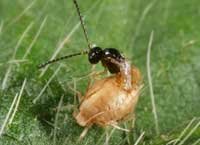
A parasitic wasp (parasitoid) emerging from a parasitized aphid. - Integrating biological control with other management strategies. Treatment thresholds may need adjusting to account for the contribution of host resistance and beneficials.
Aphid predators are common in soybean fields
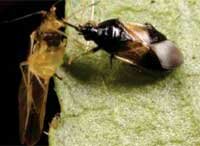 |
| Orius insidiosus with aphid. Photo credit: Matt O'Neil |
 |
|
|
| Ladybeetle adults (top) and larva (bottom) are both common aphid predators. Photo credit: Marlin E. Rice |
Predators are abundant and the most easily observed natural enemy of aphids in soybean fields. Common predators include
- many species of lady beetles and their larvae (especially the multicolored Asian lady beetle, Harmonia axyridis)
- the incidious flower bug, Orius insidiosus
- larvae of the syrphid fly (hover fly or flower fly)
- lacewing larvae
These common predators are good ones to know. Helpful publications for the identification of beneficial insects are Identifying Natural Enemies in Crops and Landscapes E-2949, a pocket flip guide from Michigan State University, and Biological control of insects and mites: An introduction to beneficial natural enemies and their use in pest management. (University of Wisconsin Cooperative Extension Publication A3842).
Application of broad-spectrum foliar insecticides will kill beneficial insects, and create the opportunity for soybean aphid populations to rebound in a "natural enemy-free space" if applied too early. This is because aphids are all female during the summer and don't need to mate. The reproduction of natural enemies is much slower and requires time for mating, egg-laying, and hatch.
Aphid parasitoids are specialized and highly effective
A lesser known, but highly effective group of aphid natural enemies are the parasitic wasps, also called parasitoids. Parasitic wasps are tiny, free-living insects in the adult stage, but in the larval stage are parasitic. They are highly specialized and effective natural enemies of aphids, and their numbers are reported to be increasing in the north central region.
The adult parasitoid lays eggs in the host, which hatch and eat their hosts from within, ultimately killing the host. Under favorable conditions, parasitoid numbers can increase rapidly and reduce aphid populations dramatically. In Asia, soybean aphid parasitoids play a large role in keeping aphid populations at non-pest status.
 |
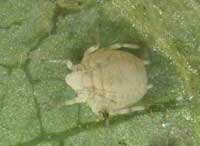 |
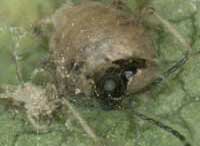 |
| A parasitic wasp, Aphelinus albipodus., lays eggs in a soybean aphid.. Photo credit: University of Wisconsin |
The parasitized dead aphid is called a "mummy". It looks like a puffy brown, black or tan version of the aphid. Photo credit: Dan Mahr |
The larval and pupal stages occur inside the mummy, from which the new adult wasp emerges. Photo credit: Camila Botero |
Entomologists in the North Central region have identified soybean aphid parasitoids as possible agents for classical biological control. As part of an NCSRP checkoff-funded aphid biological control project, a number of aphid parasitoids have been identified and brought back to the U.S. where they have been in quarantine. Several years of research have been conducted on the biology, safety, and non-target impacts of potential candidates. Read more about current importation biological control»
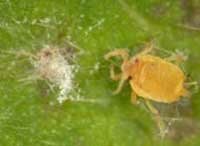 |
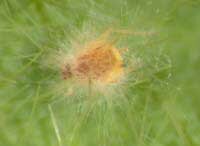 |
| Aphids being colonized by the entomopathogenic fungus, Paecilomyces lilacinus Photo credit: Bill Stoneman |
Aphid fungal pathogens can devastate aphid populations in humid weather
Insects, like plants and animals, are attacked by microorganisms that cause disease. In particular, fungal diseases can infect a high percentage of an aphid population very rapidly, resulting in significant levels of control.
Entomologists in Minnesota and in Wisconsin have found high levels of diseased aphids on soybean, especially later in the growing season. Aphids infected by fungi will have varying degrees of "fuzzy" fungal mycelial growth emerging from the dead bodies. This mycelium produces spores which are released into the environment and infect additional insects.
Foliar fungicides applied to soybean are detrimental to this group of natural enemies. Fungicide applications should be minimized or avoided to preserve these beneficial fungi.
Resources
- Biology of the soybean aphid, Aphis glycines, in the United States. Tilmon, K J. et al. Journal of Integrated Pest Management, 2011
- Biological Control of Insect Pests on Field Crops in Kansas (pdf)
- The publication Soybean Aphids in Iowa (pdf format) has a section and photos on aphid natural enemies.
- Identifying Natural Enemies in Field Crops. Field manual E2949, available from Michigan State University Extension Bookstore
- Biological control of insects and mites: An introduction to beneficial natural enemies and their use in pest management. University of Wisconsin Cooperative Extension Publication A3842 . Mahr, D.L., Whitaker, P., Ridgway, N.M. 2008 (print copies available from the UW Learning Store).

